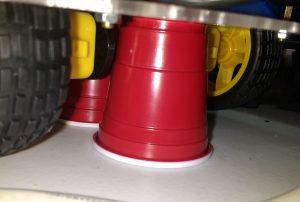In the initial assembly of the car, tests are needed to determine how to use 3rd party libraries and whether the components of the car are wired up correctly. The Arduino with its Motor Driver Shield is mounted and the four DC motors with wheels attached are wired into the Motor Driver Shield. The Raspberry Pi has not been installed. Therefore, any tests run with the Arduino require the Arduino to be connected to my laptop by an USB cable.
My first set of software tests was to see if I could make the wheels turn. The USB cable is only 3 feet long. It would be a bad idea to try to turn the wheels while the wheels are resting on the ground or table, especially since the speed of the wheels was unknown during the initial testing. It would take very little spinning of the wheels for the car to reach the end of its USB cable that is also attached to a laptop.
So, how do you spin the wheels on the car so it goes nowhere in the process? One possibility is to flip the car upside down. Since I flipped the bottom platform, the wheels do not extend above the top platform. This would result in the car resting on the upside down Arduino. Not something that I wanted to do.
The solution that I chose was to model how a mechanic works on a real car. Put the car up on blocks so that the wheels do not touch the ground. As far as I know, nobody makes miniature jacks or blocks for model cars. I improvised. For blocks I used three miniature red plastic cups that stand 2 inches tall. One at either end of the car plus an extra cup in the middle provided enough lift to get the wheels off of the table.


